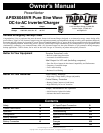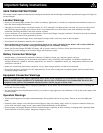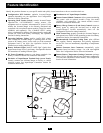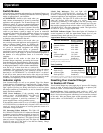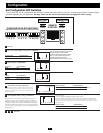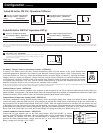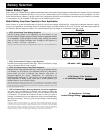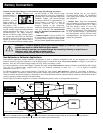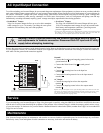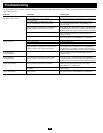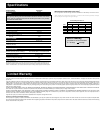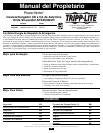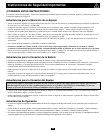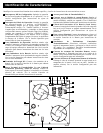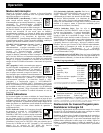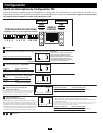
6
Configuration
(continued)
Set Battery Charge Conserver (Load Sense) Control—OPTIONAL
In order to save battery power, the unit's inverter automatically shuts off in the absence of any power demand from
connected equipment or appliances (the electrical load). When the Inverter/Charger detects a load, it automatically turns
its inverter function on. Users may choose the minimum load the Inverter/Charger will detect by adjusting the Battery
Charge Conserver Control (see diagram). Using a small tool, turn the control clockwise to lower the minimum load that
will be detected, causing the inverter to turn on for smaller loads. When the control is turned fully clockwise, the inverter
will operate even when there is no load. Turn the control counterclockwise to increase the minimum load that will be
detected, causing the inverter to stay off until the new minimum load is reached.
NOTE: The factory setting for the control is fully clockwise. However, based on the threshold load to which you’d like the inverter to respond, you should adjust the control counterclockwise to reduce
its sensitivity until the inverter is active only when connected equipment or appliances are actually in use.
Connect Remote Control—OPTIONAL
The unit features an 8-conductor telephone style receptacle on the front panel for use with an optional remote control module (Tripp Lite
model APSRM4, sold separately). The remote module allows the Inverter/Charger to be mounted in a compartment or cabinet out of sight, while
operated conveniently from a remote location. See instructions packed with the remote control module.
LOAD
SENSE
MAX OFF
Connect Battery Temperature Sensing Cable—OPTIONAL
The battery temperature sensing function prolongs battery life by adjusting the charge float voltage level based on battery temperature.
Connect the sensor cable (the cable has an RJ style connector on one end and a black sensor on the other) to the RJ style jack located on
the front panel of the Inverter/Charger labeled “RMT BATT TEMP.” With user-supplied electrical or duct tape, affix the sensor to the side
of the battery below the electrolyte level. Make sure that nothing, not even tape, comes between the sensor and the side of the battery. To
guard against false readings due to ambient temperature, place the sensor between batteries, if possible, or away from sources of extreme
heat or cold. If the sensor cable is not used, the Inverter/Charger will charge according to its default value (25º C).
Connect Automatic Generator Starter—OPTIONAL
Connect the RJ type modular jack on the front panel labeled “RMT GEN START” to vehicle
generator ON/OFF switching mechanism with user-supplied cable (see Pin Configuration Diagram).
Once attached, the interface will allow the Inverter/Charger to automatically switch a vehicle
generator on when connected battery voltage levels are low ( 46.0 VDC) and switch it off when
battery voltage levels are high ( 56.4 VDC).
Pin Configuration
2 - Common
3 - N.C.
(Normally Closed)
4 - N.O.
(Normally Open)
1
2
3
4
5
6
<
<
Switch #4 Set for 230 VAC Operation (#4 Down)
270 V
260 V
Select High AC Input Voltage Point for
Switching to Battery - OPTIONAL*
Voltage Switch Position
270 VAC Up
260 VAC Down (factory setting)
11
9 10 11 12
180 V
170 V
Select Low AC Input Voltage Point for
Switching to Battery - OPTIONAL*
Voltage Switch Position
180 VAC Up
170 VAC Down (factory setting)
10
9 10 11 12
Switch #4 Set for 208 VAC Operation (#4 Up)
Select High AC Input Voltage Point for
Switching to Battery - OPTIONAL*
Voltage Switch Position
245 VAC Up
235 VAC Down (factory setting)
11
245 V
235 V
9 10 11 12
Select Low AC Input Voltage Point
for Switching to Battery - OPTIONAL*
Voltage Switch Position
175 VAC Up
165 VAC Down (factory setting)
10
165 V
175 V
9 10 11 12
* Most of your connected appliances and equipment will perform adequately when your Inverter/Charger’s High AC Input Voltage Point and its Low AC Voltage Input Point is left in the factory setting . However, if the unit frequently switches to battery power due to momentary
high/low line voltage swings that would have little effect on equipment operation, you may wish to adjust these settings. By increasing the High AC Voltage Point and/or decreasing the Low AC Voltage Point, you will reduce the number of times your unit switches to battery
due to voltage swings.
Select Battery Type - REQUIRED
Battery Type Switch Position
Gel Cell (Sealed) Battery Up
Wet Cell (Vented) Battery Down (factory setting)
12
CAUTION: The Battery Type DIP Switch setting must match the type of batteries you connect,
or your batteries may be degraded or damaged over an extended period of time. See “Battery
Selection,” for more information.
9 10 11 12



